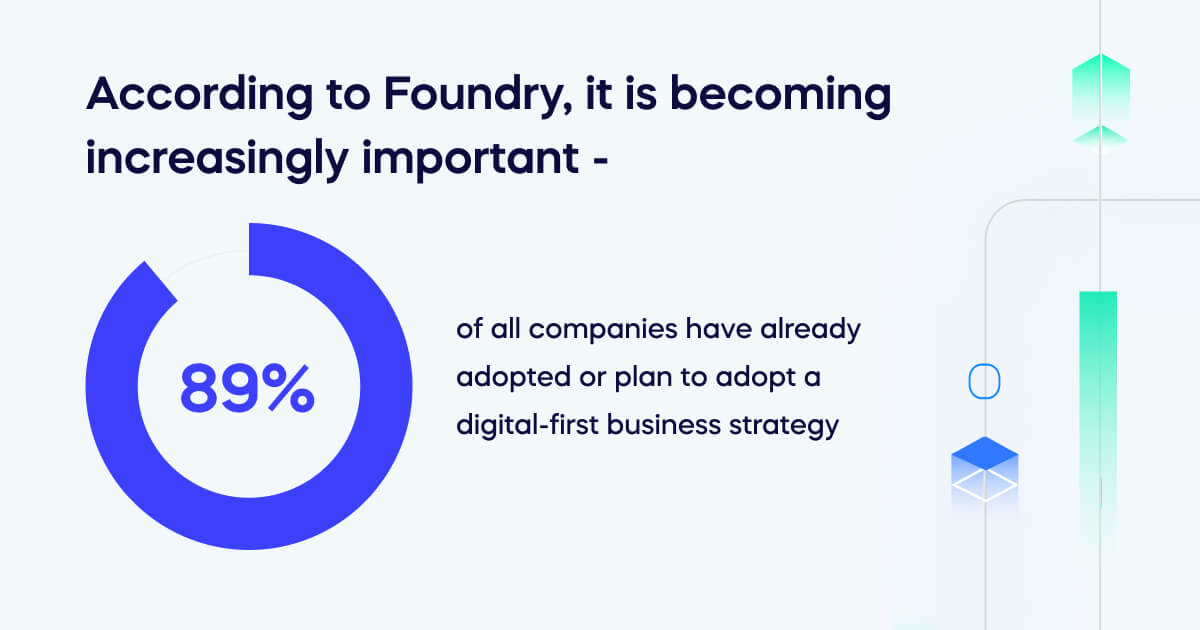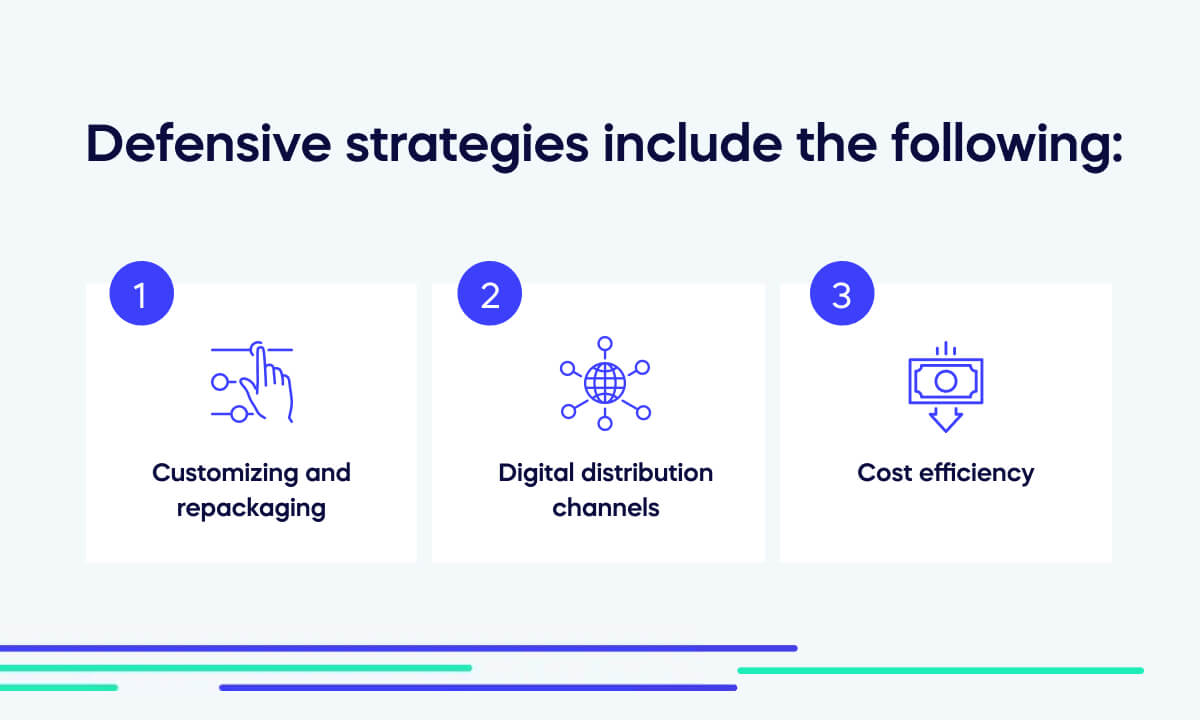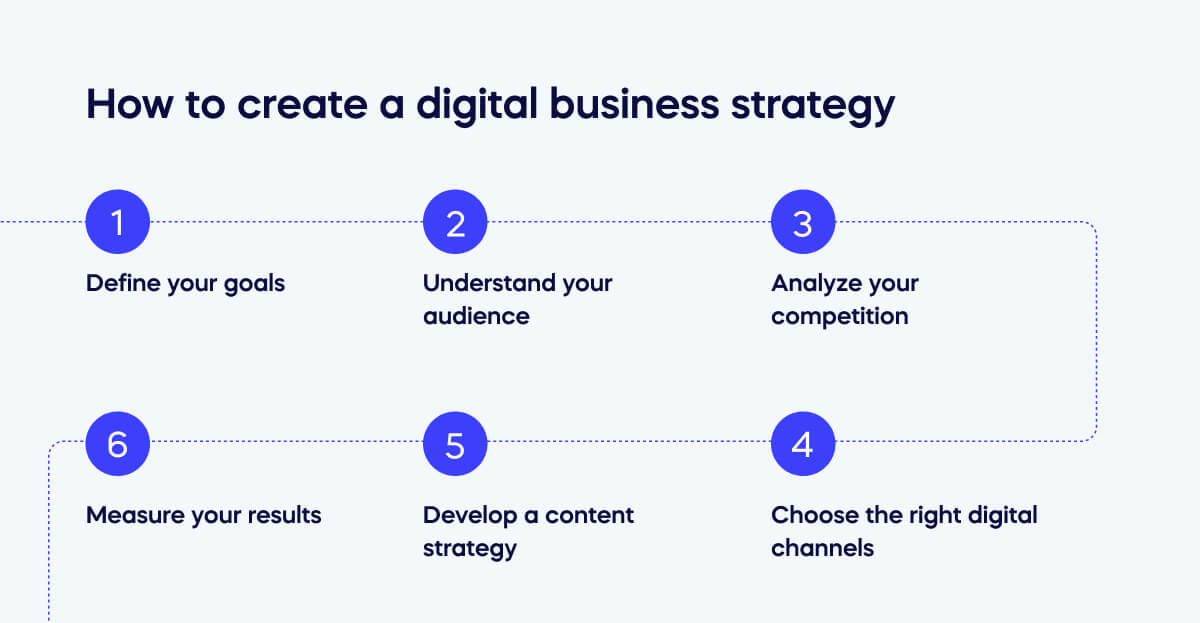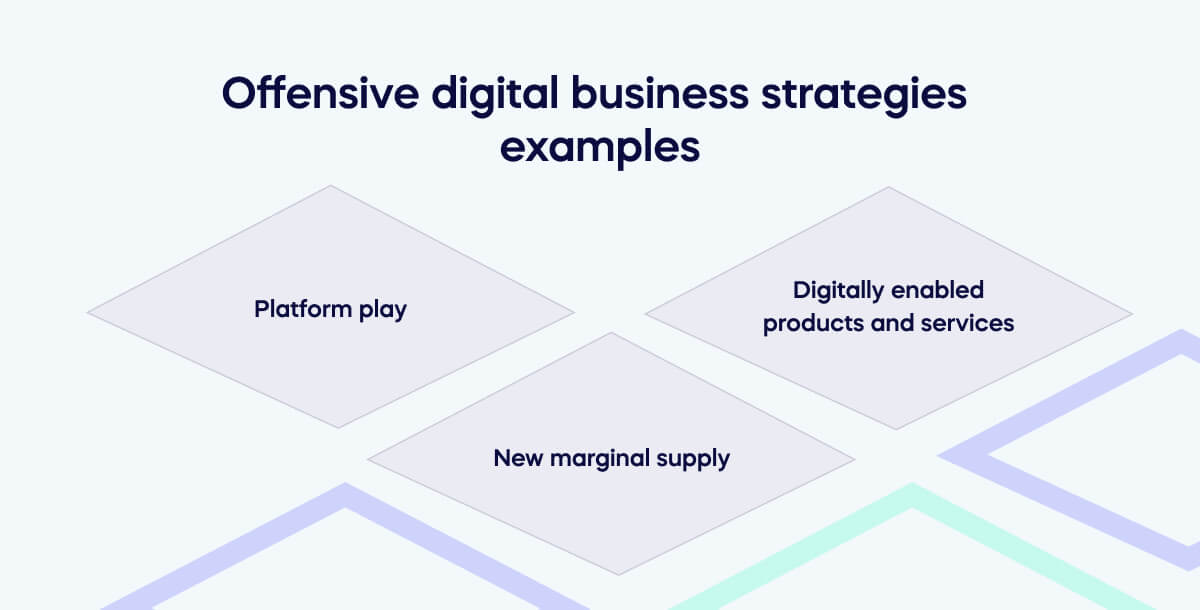A digital business strategy is a plan for how a company will use digital technologies to achieve its business goals. According to Foundry, it is becoming increasingly important – 89% of all companies have already adopted or plan to adopt a digital-first business strategy.
Companies must ensure their strategy is aligned with overall business plans, considering the organization’s unique strengths, weaknesses, opportunities, and threats.

Furthermore, digital business strategies should be flexible and adaptable, as the digital landscape constantly changes. Companies should regularly review them to ensure they are aligned with their overall business goals to take advantage of the latest technologies.

Types of digital business strategy
There are two main types of digital business strategy: offensive and defensive.

Offensive strategy
Offensive digital business strategies are designed to help companies grow and expand their market share.
They involve using digital technologies to create new products and services, enter new markets, or change how the company delivers its products and services to customers.
Here are some examples of such strategies:
Platform play
Developing a digital platform that other businesses can use to build their own products and services.
Example
Amazon started out as an online bookseller, but it has since expanded into a wide range of other markets, including cloud computing, logistics, and streaming video.
Amazon’s platform provides businesses with a way to sell their products and services to Amazon’s customers, and it also provides customers with a convenient way to shop for a wide range of products and services.
New marginal supply
Creating new products and services that are not possible or efficient to produce using traditional methods.
Example
Netflix allows customers to watch movies and TV shows on demand. Previously, people would have had to rent or buy DVDs, but thanks to the internet and technologies such as compression, they can now access a huge range of titles on the platform.
Digitally enabled products and services
Improving existing products and services to create new digital versions of them.
Example
Spotify saw an opportunity to improve music streaming by providing a digital subscription service that unlocks millions of songs to everyone with a laptop or smartphone and an internet connection.
Previously, people had to buy CDs or records; then, they had to purchase tracks and albums individually on platforms such as iTunes.
Defensive strategy
Defensive digital business strategies help companies protect their existing business from digital disruption.
They involve using digital technologies to improve the customer experience, operational efficiency, and cost-effectiveness.
Defensive strategies include the following:
Customizing and repackaging
A company uses digital technologies to customize and repackage its existing products and services to meet the needs of different customer segments.
Example
Nike’s website allows customers to customize their own Nike shoes with different colors, materials, and designs.
The company also offers a variety of digital fitness products and services, such as the Nike Training Club app.
Digital distribution channels
A company uses digital channels to distribute its products and services to customers.
Example
Walmart sells its products through its website and mobile app, offering curbside pickup and delivery services.
These digital distribution channels make it easier for customers to shop with the brand.
Cost efficiency
A company uses digital technologies to automate tasks, streamline processes, and reduce costs.
Example
Amazon uses robots to automate its fulfillment process and artificial intelligence to improve its customer service and product recommendations.
These technologies help the company to keep its costs low and offer competitive prices to its customers.

Combining strategies
Companies can also adopt a combination of offensive and defensive digital business strategies.
For example, a company might develop a new digital product or service (offensive strategy) while also using digital technologies to improve the efficiency of its existing operations (defensive strategy).
How are digital business strategy and digital transformation connected?
Digital business strategies and digital transformation are closely linked concepts, and one often drives the other.
Digital business strategies set the direction and goals for how a company leverages digital technologies to achieve its objectives.
Digital transformation is implementing these strategies, involving changes in technology, culture, processes, and capabilities to realize the desired outcomes.
They are interdependent and work together to enable organizations to thrive digitally.
How to create a digital business strategy
Define your goals
What do you want to achieve with your digital business strategy? Do you want to increase brand awareness, generate leads, drive sales, or improve customer satisfaction? Once you know your goals, you can develop strategies to achieve them.
Understand your audience
Who are you trying to reach with your digital business strategy? What are their needs and wants? What digital channels do they use? Once you understand your audience, you can tailor your strategy to reach them effectively.
Analyze your competition
What are your competitors doing well in terms of digital marketing? What could they be doing better? Analyzing your competition can help you to identify opportunities and develop a strategy that gives you a competitive advantage.
Choose the right digital channels
Many different digital channels are available, such as social media, search engine optimization (SEO), pay-per-click (PPC) advertising, and email marketing. You need to choose the channels that are most relevant to your audience, which will help you achieve your goals.
Develop a content strategy
Content is essential for any digital business strategy. You need to create high-quality content that is relevant to your audience and will help you achieve your goals. Your content strategy should include a variety of content formats, such as blog posts, articles, videos, and infographics.
Measure your results
It’s important to track your results to see what’s working and what’s not. This will help you to refine your strategy over time. You can use various tools to track your results, such as Google Analytics and social media analytics tools.

